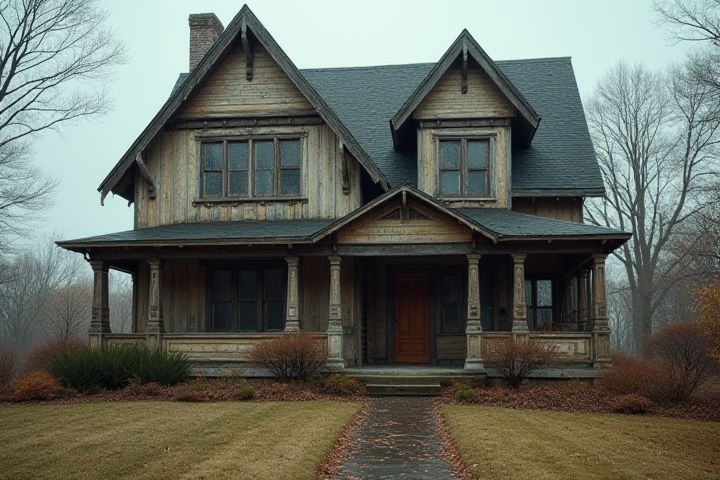
Your house may be drafty due to gaps and cracks in windows, doors, and other openings that allow air leaks. Poor insulation in walls, ceilings, and attics can contribute to heat loss and cold drafts, making your living space uncomfortable. Old or damaged weatherstripping around doors and windows can exacerbate this issue, requiring replacement for better energy efficiency. Inadequately sealed electrical outlets and light fixtures may also be potential sources of drafts, as unsealed areas can let outside air infiltrate your home. Conducting a thorough inspection and using caulk or insulation can improve your home's airtightness and reduce unwanted drafts.
Why Is My House Drafty
Poor insulation
Poor insulation is a primary contributor to a drafty house, as it allows air leaks to occur in walls, ceilings, and floors. Inadequate insulation materials or improper installation can lead to significant heat loss during winter months and unwanted heat gain in summer. You may also notice cold spots near windows, doors, and electrical outlets if insulation is lacking or damaged. Investing in quality insulation solutions not only improves comfort but also enhances energy efficiency, ultimately reducing your utility bills.
Gaps around windows
Gaps around windows can significantly contribute to a drafty house, allowing cold air to infiltrate and conditioned air to escape. These openings, often caused by settling or poor installation, can range from a few millimeters to over an inch wide, impacting your home's energy efficiency. In fact, studies suggest that about 30% of heating or cooling energy can be lost through inadequately sealed windows. Sealing these gaps with weatherstripping or caulk can enhance comfort and potentially reduce your energy bills by 10% to 20%.
Faulty weatherstripping
Faulty weatherstripping can significantly contribute to a drafty home, allowing cold air to penetrate through gaps around doors and windows. Over time, materials such as rubber or foam can degrade, lose their flexibility, or become dislodged, causing ineffective seals. Inspecting and replacing worn-out weatherstripping can enhance your home's energy efficiency, preventing heat loss and reducing heating costs. Ensuring tight seals not only improves comfort but also contributes to a healthier indoor environment by minimizing moisture and dust infiltration.
Unsealed doors
Unsealed doors often contribute significantly to a drafty home, allowing cold air to seep in and conditioned air to escape. Gaps around door frames, improperly installed thresholds, or worn weather stripping can create pathways for drafts. Strategically applying weather stripping or door sweeps can effectively seal these openings, improving your home's energy efficiency. Regularly inspecting your doors ensures that any deterioration is promptly addressed, enhancing comfort and reducing heating costs.
Chimney drafts
Chimney drafts occur when cold air enters your home through the chimney, often leading to uncomfortable temperatures and increased energy bills. This can happen due to improper chimney design, inadequate flue size, or the chimney being uncapped, allowing cold air to flow in freely. Cracks in the chimney structure and gaps around the flue can also contribute to these drafts, reducing your home's energy efficiency. To mitigate this issue, consider installing a chimney cap, sealing any gaps, and ensuring that your chimney is properly maintained and lined.
Attic ventilation leaks
Drafty conditions in your home often stem from inadequate attic ventilation, which can lead to significant air leaks. With proper ventilation, the temperature in the attic remains regulated, minimizing the chance of warm, moist air escaping through gaps and cracks. Studies show that nearly 30% of heat loss occurs through poorly sealed attics, emphasizing the importance of addressing these leaks. Inspecting your attic for insulation quality and sealing any found openings can drastically improve your home's energy efficiency and comfort.
Crawl space air gaps
Draftiness in your house is often linked to crawl space air gaps, which can allow cold air to seep in and disrupt indoor comfort. Research indicates that nearly 30% of your home's heat loss may originate from inadequately sealed crawl spaces. Inspecting your crawl space for gaps around vents, ducts, and the foundation can reveal critical areas needing attention. Sealing these gaps with proper insulation materials not only enhances energy efficiency but can also lower heating costs by as much as 20%.
Ductwork leaks
Drafty houses often result from ductwork leaks, where conditioned air escapes from damaged or poorly insulated ducts. These leaks can occur in various locations, including the attic, basement, or crawl spaces, allowing outdoor air to infiltrate your living space. Inspect your ductwork for gaps or holes, as these can significantly undermine your heating and cooling efficiency, leading to increased energy bills. Sealing these leaks with appropriate materials not only improves comfort but also enhances indoor air quality by reducing the entrance of dust and allergens.
Wall cracks
Drafty houses often have wall cracks as a significant contributing factor, allowing cold air to infiltrate your living space. These cracks can result from settling, aging materials, or even temperature fluctuations, leading to a loss of insulation and increased energy costs. In fact, a study indicates that drafty homes can lead to energy loss of up to 30%, affecting heating efficiency. Regularly inspecting and sealing wall cracks can improve comfort, maintain consistent indoor temperatures, and reduce monthly utility bills.
Flooring gaps
Drafty houses often result from flooring gaps, which can create pathways for air leakage. These gaps, commonly found between floorboards or at the junction of the floor and walls, can significantly impact your home's energy efficiency. In fact, even a gap as small as 1/8 inch can allow a considerable amount of airflow, raising your heating and cooling costs by up to 20%. To mitigate this issue, consider sealing gaps with caulk or using insulation products specifically designed for flooring applications.
